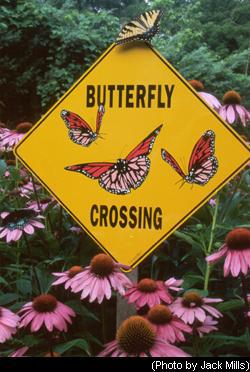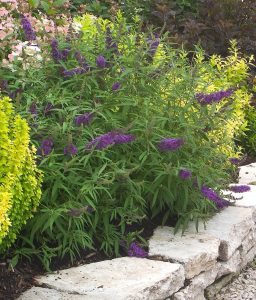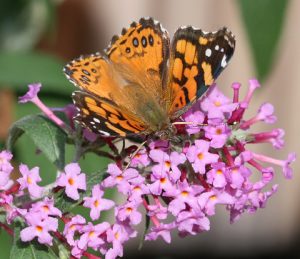by Ken Lain, the mountain gardener
Monarch and Swallowtail butterflies flock to this impress bush. Spectacular 8″ inch flowers fill the yard with fragrance and beauty used in flower arrangements and foundation plantings. Heat, drought, and wind only make this shrub bloom more. Tough enough to grow in clay, but hardy enough to shine in containers. With so many colors to choose, every yard should have at least two.

Butterfly bush (Buddleia davidii) is a deciduous shrub with an arching habit and impressive summer flowers. It’s easy to grow and produces striking flower spikes in several colors, pink, yellow, blue, and multicolors. And as the name suggests, these shrubs are known as magnets for butterflies. You’ll find even hummingbirds are attracted to butterfly bush.
Butterfly bushes were first brought to England from Asia in 1774 by the botanist Adam Buddle (for whom the plant was named). New varieties are still being discovered in remote areas of China and the Himalayas.
Botanical Name Buddleja davidii
Common Names Butterfly bush
Plant Type Deciduous shrub
Mature Size 4 to 12 feet tall; 3- to 8-foot spread (depends on variety)
Sun Exposure Full sun
Soil Type Medium moisture, well-drained soil
Soil pH 6.0 to 7.0; slightly acidic to neutral
Bloom Time June to September
Flower Color Shades of purple, pink, blue, white, yellow
Hardiness Zones 5 to 9 (USDA)
Native Area Rocky slopes in China
How to Grow Butterfly Bush
The popularity of butterfly bushes is no surprise. They are beautiful, easy to grow with minimal care. Even major storms have little effect on these hardy shrubs. They thrive in harsh environments, such as polluted urban settings, windy hilltops, and crusty dry soil. They’re also resistant to insects, drought, and stress. The bushes require little attention, so even weekend gardeners can enjoy their stunning flowers and resident butterflies.
Butterfly bush enjoys well-drained soil, medium moisture, and the more sun this beautiful bush has, the more flower it produces. Blend in Watters Premium Mulch before planting to soften mountain soils, and increase root production.
In colder climates, the butterfly bush often dies back to the ground in winter and is treated like a herbaceous perennial. And in warmer Arizona climates, they can be pruned back, in the same way, to keep them under control and stimulate better blooming.

There are no serious pest or disease problems with the butterfly bush. However, spider mites can be an issue, nematodes and grubs are sometimes found.
Light
Butterfly bush needs full sun and will become weedy and sparse if grown in shady conditions.
Soil
This plant thrives in any average, well-drained soil that gets any amount of moisture.
Water
This plant likes a medium-moisture environment and will do poorly in boggy locations that don’t drain well. They will thrive on 1/2 inch of water by rain or irrigation each week.
Temperature and Humidity
Butterfly bush thrives throughout its hardiness zone range, but expect it to die back to ground level like a perennial flower in zones 5 and 6.
Fertilizer
Feed with 7-4-4 All Purpose Food three times per year for amazing flowers. This natural food is spread like salt-and-pepper around the base of the bush every Easter, July 4th, and Halloween for amazing results.
Varieties of Butterfly Bush
Larger varieties include Buddleia x weyeriana, and Buddleja davidii ‘Black Night’. We have several new introductions that are less aggressive, don’t produce seed, and require less pruning here at Watters Garden Center.

Buddleja x ‘Blue Chip’ is a smaller, 3-6′ foot variety sterile and produces no seeds, with stunning purple flowers.
Buddleja ‘Miss Ruby’ is another sterile variety, growing 4-5′ feet tall and wide covered in deep red flowers.
Other cultivars are bred to be seedless include Asian Moon, Ice Chip, Inspired Pink, Purple Haze, and the various Flutterby Grande cultivars.
Pruning
The spent flower spikes of butterfly bush should be removed promptly after flowering to stimulate continued blooming right up to frost. This plant grows fast, and pruning it down to ground level each spring stimulates vigorous growth and profuse flowering.
Butterfly bushes are cultivated to suit many different gardening preferences. Some grow up to 10 feet tall, while others are relatively small. Some varieties produce large clusters of flowers, while others produce striking spikes.
Planting
The ideal months to plant a new butterfly bush on your own are best April through October. How to Plant a Butterfly Bush.

